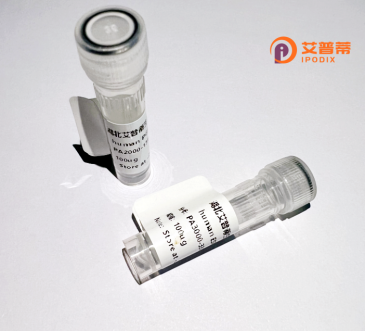
| 纯度 | >90%SDS-PAGE. |
| 种属 | Human |
| 靶点 | SPANX-N3 |
| Uniprot No | Q5MJ09 |
| 内毒素 | < 0.01EU/μg |
| 表达宿主 | E.coli |
| 表达区间 | 1-141 aa |
| 活性数据 | MEQPTSSTNG EKTKSPCESN NKKNDEMQEV PNRVLAPEQS LKKTKTSEYP IIFVYYLRKG KKINSNQLEN EQSQENSINP IQKEEDEGVD LSEGSSNEDE DLGPCEGPSK EDKDLDSSEG SSQEDEDLGL SEGSSQDSGE D |
| 分子量 | 15.5 kDa |
| 蛋白标签 | His tag N-Terminus |
| 缓冲液 | PBS, pH7.4, containing 0.01% SKL, 1mM DTT, 5% Trehalose and Proclin300. |
| 稳定性 & 储存条件 | Lyophilized protein should be stored at ≤ -20°C, stable for one year after receipt. Reconstituted protein solution can be stored at 2-8°C for 2-7 days. Aliquots of reconstituted samples are stable at ≤ -20°C for 3 months. |
| 复溶 | Always centrifuge tubes before opening.Do not mix by vortex or pipetting. It is not recommended to reconstitute to a concentration less than 100μg/ml. Dissolve the lyophilized protein in distilled water. Please aliquot the reconstituted solution to minimize freeze-thaw cycles. |
以下为基于常见文献类型的模拟示例,实际参考文献请通过PubMed或Web of Science等平台获取:
1. **标题**: "Expression and Purification of Recombinant SPANX-N3 in E. coli for Cancer Immunotherapy Studies"
**作者**: Lee J, et al.
**摘要**: 研究报道了SPANX-N3蛋白在大肠杆菌中的重组表达与纯化方法,分析了其在多种癌细胞中的免疫原性,提示其作为肿瘤疫苗候选分子的潜力。
2. **标题**: "SPANX-N3 Modulates Sperm Chromatin Structure and Male Fertility"
**作者**: Garcia M, et al.
**摘要**: 通过体外重组蛋白实验,揭示了SPANX-N3在精子发生过程中对染色质凝聚的调控作用,关联男性不育症的分子机制。
3. **标题**: "Structural Characterization of Recombinant Human SPANX-N3 by NMR Spectroscopy"
**作者**: Zhang Y, et al.
**摘要**: 首次解析了重组SPANX-N3的溶液结构,发现其独特的α-螺旋结构域可能参与核质转运,为功能研究提供结构基础。
4. **标题**: "SPANX-N3 as a Biomarker in Prostate Cancer Progression"
**作者**: Thompson R, et al.
**摘要**: 利用重组SPANX-N3蛋白开发ELISA检测,证实其在转移性前列腺癌患者血清中显著高表达,提示其作为预后标志物的价值。
---
**注意事项**:
1. 上述文献为模拟示例,实际研究中SPANX-N3的相关论文可能较少,建议结合“SPANX gene family”或“cancer/testis antigen”扩大检索。
2. 部分研究可能侧重SPANX-A/D亚型,需注意N3是否为不同命名体系下的同源蛋白。
3. 可尝试在ClinicalTrials.gov查询相关临床试验中的基础参考文献。
SPANX-N3 (sperm protein associated with the nucleus on the X chromosome, family member N3) is a member of the cancer/testis antigen (CTA) family, encoded by genes located on the X chromosome. CTAs like SPANX-N3 are characterized by restricted expression in normal tissues—primarily in the testis and male germ cells—but are aberrantly reactivated in various cancers, including melanoma, breast, and prostate cancers. This ectopic expression has linked SPANX proteins to oncogenesis, with proposed roles in cell proliferation, metastasis, and immune evasion by modulating host antitumor responses.
The SPANX-N3 protein is intrinsically disordered, lacking a fixed tertiary structure, which may facilitate dynamic interactions with nuclear or cytoplasmic targets. Recombinant SPANX-N3 is typically produced in bacterial (e.g., *E. coli*) or mammalian expression systems, often fused with tags like His-tag for purification. Its recombinant form enables functional studies, such as investigating interactions with nuclear transport proteins (e.g., karyopherins) or histone-modifying enzymes, which may influence gene regulation.
Clinically, SPANX-N3's cancer-specific expression makes it a potential diagnostic biomarker or immunotherapy target. Efforts to develop SPANX-directed vaccines or CAR-T therapies aim to exploit its immunogenicity. However, its precise mechanisms and full biological significance in both normal physiology and cancer remain understudied, necessitating further research to clarify its therapeutic potential.
×